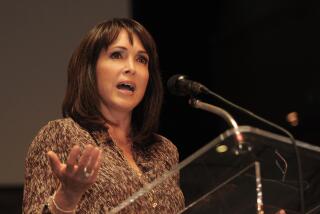Finding Some Faults in KABC’s ‘Quakebusters’
- Share via
No more sand in the face for KABC-TV Channel 7, which now finds itself in the unaccustomed position of trailing first-place KNBC Channel 4 in the local news ratings.
Time to get tough.
On Thursday, Channel 7 began the May ratings sweeps (which inevitably begin at the end of April) with a huge tremor that could be described as earthshaking.
Always providing more than its share of theater, “Eyewitness News” this time crossed into entertainment with a brazenness said to have shocked and distressed even many of its own staffers.
What’s next, 3-D news?
Performed by its very own “Eyewitness News” actors in the studio and in the field, plus a supporting cast of hundreds, Channel 7’s newest and most outrageous theatrical production yet was “Quakebusters,” an extended, live simulation of an earthquake disaster that consumed about half of the 4, 5 and 6 p.m. newscasts.
Sandwiched between real news, each of these half-hour dramatizations represented a different day of make-believe earthquake coverage, and to Channel 7’s credit, each was continuously labeled “simulation” in English and Spanish.
The credit ended there.
With Jerry Dunphy and Marianne Banister watching from the real anchor desk, weathercaster Dr. George Fischbeck kicked off “Quakebusters” by saying that the key to survival of the “big one” is “awareness and planning.”
He added that the day’s coverage “may look real,” but it’s “only a drill.” Some of us have suspected that about “Eyewitness News” for years.
It was time to raise the curtain. Cut to anchorman Paul Moyer, in his shirt-sleeves, at the “earthquake desk.”
“I’m Paul Moyer in the ‘Eyewitness’ newsroom. A very strong earthquake shook the Southland just a short time ago. So far we don’t know really how big it was. But I can tell you one thing--our studio here in Hollywood shook for about three minutes. . . .”
Cut to reporter John North in the field, in front of rubble, reporting “three or four injuries here.” One of the injured was in a pickup, other people were on the ground. “I live in a building a couple of doors down,” a worried woman told North.
Back to Moyer. “We advise you to please stay calm,” he said before a commercial.
Again back to Moyer. “Information is beginning to come in.” The screen was filled with overhead shots of fires as Moyer used such words as overwhelming and widespread to describe the disaster.
Now to reporter Marc Brown in the field, in front of fire trucks, talking to a department spokesman. “We know the fire department is stretched pretty thin right now. . . .”
Back to Moyer, with news that the quake registered 8.3 on the Richter scale. “It’s now very clear, the so-called ‘big one’ has indeed struck Southern California.”
Now to reporter Mark Coogan in field, interviewing a family. “Folks, how are you and how are things inside?”
Back to Moyer, who reported “at least 50 deaths” as the screen filled with the carnage.
Now to reporter Harold Greene in the field, bending over a bloodied victim at a makeshift treatment center. “What happened to you, sir?” he asked. “The hot-water heater exploded,” the groaning victim replied.
“Many people here appear to be in shock,” Greene reported.
Now to Bob Banfield in the field, waiting for the injured to emerge from a collapsed building in San Bernadino. One man was being carried. “This person here lost a limb,” Banfield said.
Back to Moyer. “The death toll is now at least 270. . . .”
The 4 p.m. newscast’s “Day One” coverage ended with Ann Martin previewing the 5 p.m. newscast and saying: “The aim of all of what we’re doing today is to help you get ready for an earthquake.”
A second opinion: The primary aim of “Quakebusters” was to hype the ratings (which it apparently did; all three newscasts outdrew the competition on KNBC and KCBS Channel 2). In the process, it elevated entertainment far, far above news.
The reporters in the field worked survival tips into their “coverage,” so there was no question that good information was available from “Quakebusters.” But this was the stuff of an entertainment program, not a newscast. News should be reported, not scripted and acted out.
As this was theater, a review of the performances seems in order:
Beyond a doubt, Moyer gave his finest performance in his most challenging role, conveying concern and urgency so convincingly that you’d think he was a real journalist.
Although Greene tended to overact, one could only marvel at his pacing and interaction, while North, Brown, Coogan and Banfield were believable enough to have you on the edge of your seat.
What a cast!
The anchors switched for the 5 p.m. newscast, with Moyer, now in his jacket, taking over as the real anchor beside Martin, and Dunphy, with his tie loosened, now sitting at the “earthquake desk” for simulated “Day Two.”
Some of the real news reported by Moyer and Martin (“What if you were driving and suddenly the street fell in. . .”) looked and sounded like the simulated news that Moyer had reported in the previous hour, further merging fantasy and reality.
And there on cue to introduce “Day Two” was Dr. George. “Oh, boy!” he exclaimed about “Quakebusters,” “It’s never been done before.”
With good reason.
It’s hard to imagine a self-respecting news organization doing something like this. Come to think of it, no self-respecting news organization did.
More to Read
The complete guide to home viewing
Get Screen Gab for everything about the TV shows and streaming movies everyone’s talking about.
You may occasionally receive promotional content from the Los Angeles Times.






